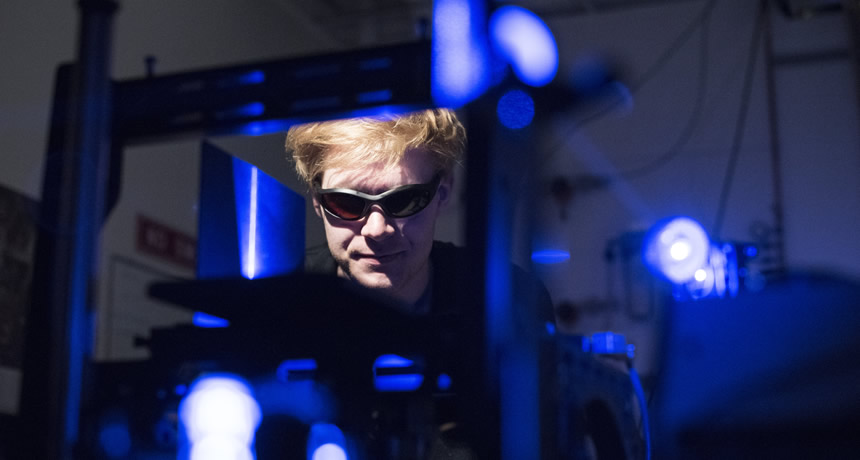
Undergraduate physics student Peter West in Al Meldrum's laser lab. Dr. Meldrum's group is using silicon quantum dots to build microsensors. Photo: Epic Photography.
A research lab at the University of Alberta is building ground-breaking environmental sensors comprised of millions of quantum dots.
Dr. Al Meldrum, the Department of Physics professor who leads this research, says, "We were initially interested in the effects that an optical cavity would have on the fluorescence properties of silicon quantum dots. We knew that if we could make the quantum dot coatings sufficiently thin, they could be used in medical and environmental sensing applications."
The quantum dot sensing elements are small - so small in fact, they might be better viewed as a painted-on surface layer, and their fluorescent properties can change as a function of their chemical environment. Meldrum's lab is using them to construct tiny micro-fluidic sensors whose applications could be extensive. "Initially, this was a "can we do this" kind of effort, but the potential application of these structures was rather obvious from the start," says Meldrum.
The science that went into developing these microsensors is impressive, reaching across many disciplines.
The sensors themselves consist of tiny tubes called capillaries that are coated on the inside with a thin layer of fluorescent quantum dots. Fluid is pumped into the channel, and then blue light is used to illuminate the capillary. The wavelengths of the red light emitted by the quantum dots can be measured to reveal the chemical nature of the fluid inside.
Quantum dots were first discovered in the 1980s. "The research really took off in the 1990s with the chemists' discovery of techniques to make highly uniform cadmium selenide quantum dots with excellent size control, good crystal structure, and fine control of the surface chemistry of the dots," says Meldrum.
The quantum dots used in Meldrum's sensors are special in that they emit light, or fluoresce, when illuminated with a laser or LED. The emitted light reflects internally inside the capillary, creating resonances called "whispering gallery modes". These resonances are an interference phenomenon that occurs when the emitted light propagates around the circular cross section of the quantum-dot layer, persisting long enough to develop strong interference patterns.
When this light is analyzed, one observes a spectrum with many sharp peaks corresponding to the resonance wavelengths. Small but clearly observable shifts in these peaks are induced by chemical changes in the environment. The sensors can be designed to respond to specific chemical interactions, and fluids may then be analyzed and identified.
These microfluidic sensors are so versatile that virtually any fluid pumped into the channel may be analyzed. The trick, Meldrum says, is that "to make the sensor specific for a desired analyte (e.g., a protein, a vitamin, a disease marker, etc.) you have to chemically treat the surface of the capillary channel to react specifically with that analyte."
Meldrum's group is working with the Veinot Research group in the Department of Chemistry to develop sensors for vitamin detection, disease biomarkers, and for a new class of "biolasing sensors". Other targets include explosives (for security applications) and environmental pollutants.
"Biosensors are probably the biggest application in mind," Meldrum says, "but there are others -- hydrocarbons in groundwater for example -- really anything you can pump into the channel as long as you can get a reaction on the surface that identifies the target analyte."